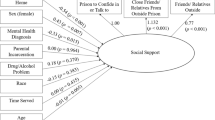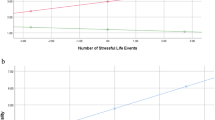Abstract
Although social integration has consistently been linked to mental well-being among the general population, this relationship has not been explored for persons confined in total institutions. Jails, in particular, represent unique conditions that have the potential to alter the traditional relationship between social ties and mental health. Although previously unexamined, social ties maintained by jail inmates outside and inside of the institution are commonly presumed to weaken some of the adverse effects of a stressful environment and positively influence mental health. The current study explores the impact of social integration on mental well-being among 198 male and female inmates incarcerated in a large county jail. The impact of marital status, parental status, and social support (both inside and outside of the jail) on various dimensions of mental health was examined. The results indicate that rather than promoting mental well-being, social relationships inside and outside of the institution are associated with higher levels of distress. Specifically, married inmates report higher levels of depression and anxiety, and inmates with close social relationships inside of the jail report higher levels of hostility, although gender differences in these patterns are evident. The results of this study suggest that social integration may play a different role for persons incarcerated in total institutions than among the general population due to the unique conditions of social stigmatization and separation from support networks.
Similar content being viewed by others
References
Aneshensel, Carol S. and Jeffrey D. Stone 1982 “Stress and Depression: A test of the buffering model of social support. ” Archives of General Psychiary 39:1392–1996.
Batten, Phillip G. 1984 “Loneliness among male prisoners. ” Dissertation Abstracts International 44(12-B):392.
Beck, Allen 1991 Profile of Jail Inmates, 1989. Washington, DC: U.S. Department of Justice, Bureau of Justice Statistics.
Belle, Deborah 1987 “Gender differences in the social moderators of stress. ” In R. C. Barnett, L. Biener, and G. K. Baruch (eds.), Gender and Stress: 257–277, New York: Free Press.
Cohen, Sheldon and Thomas A. Wills 1985 “Stress, social support, and the buffering hypothesis. ” Psychological Bulletin 98(2):310–357.
Colsher, Patricia L., Robert B. Wallace, Paul L. Loeffelholz, and Marilyn Sales 1992 “Health status of older male prisoners: A comprehensive survey. ” American Journal of Public Health 82(6):881–884.
Derogatis, Leonard 1993 Brief Symptom Inventory (BSI): Administration, Scoring, and Procedures Manual, 3rd ed. Minneapolis, MN: National Computer Systems.
Desmond, Ann M. 1991 “The relationship between loneliness and social interaction in women prisoners. ” Journal of Psychosocial Nursing 29(3):5–10.
Durkheim, Emile 1951 [originally published in 1897] Suicide: A Study in Sociology. New York: Free Press.
El-Bassel, Nabilia, Louisa Gilbert, Robert F. Schilling, Andre Ivanoff, and Debra Borne 1996 “Correlates of crack abuse among drug-using incarcerated women: Psychological trauma, social support, and coping behavior. ” American Journal of Drug Abuse 22(1):41–56.
Ensel, Walter M. and Nan Lin 1991 “The life stress paradigm and psychological distress. ” Journal of Health and Social Behavior 32:321–341.
Fogel, Catherine Ingram 1993 “Hard times: The stressful nature of incarceration for women. ” Issues in Mental Health Nursing 14:367–377.
Fogel, Catherine and Sandra Martin 1992 “The mental health of incarcerated women. ” Western Journal of Nursing Research 14(1):30–47.
Gallagher, Elaine M. 1990 “Emotional, social, and physical health characteristics of older men in prison. ” International Journal of Aging and Human Development 31(4):251–165.
Gibbs, John 1982a “Disruption and distress: Going from the street to jail. ” In N. Parisi (ed.), Coping With Imprisonment: 29–44. Beverly Hills, CA: Sage.
— 1982b “The first cut is the deepest: Psychological breakdown and survival in the detention setting. ” In R. Johnson and H. Toch (eds.), The Pains of Imprisonment: 97–114. Beverly Hills, CA: Sage.
— 1991 “Environmental congruence and symptoms of psychopathology: A further exploration of the effects of exposure to the jail environment. ” Criminal Justice and Behavior 18(3):351–374.
Gilliard, Darrell K. and Allen J. Beck 1998 Prison and Jail Inmates at Midyear 1997. Washington, DC: U.S. Department of Justice, Bureau of Justice Statistics.
Horwitz, Allan V., Julie McLaughlin, and Helene Raskin White 1998 “How the negative and positive aspects of partner relationships affect the mental health of young married people. ” Journal of Health and Social Behavior 39:124–136.
House, James S. and Robert L. Kahn 1985 “The social readjustment rating scale. ” Journal of Psychosomatic Research 11:213–218.
House, James S., Karl R. Landis, and Debra Umberson 1988 “Social relationships and health. ” Science 241:540–545.
Hurley, William and Michael Dunne 1991 “Psychological distress and psychiatric morbidity in women prisoners. ” Australian and New Zealand Journal of Psychiary 35:461–470.
Kessler, Ronald C. and Jane D. McLeod 1984 “Sex difference in vulnerability to undesirable life events. American Sociological Review 49:620–631.
King, Anthony 1993 “The impact of incarceration on African American families: Implications for practice. ” Families in Society: The Journal of Contemporary Human Services 74:145–153.
LaGory, Mark, Ferris J. Ritchey, and Jeff Mullis 1990 “Depression among the homeless. ” Journal of Health and Social Behavior 31:87–101.
Lin, Nan, Alfred Dean, and Walter Ensel 1986 Social Support, Life Events, and Depression. Orlando, FL: Academic Press.
Marsh, R. L. 1983 “Services for families: A model project to provide services for families of prisoners. ” International Journal of Offender Therapy and Comparative Criminology 27:156–162.
McCorkle, Richard C. 1992 “Personal precautions to violence in prison. ” Criminal Justice and Behavior 19(2):160–173.
Paulus, Paul B. and Mary T. Dzindolet 1993 “Reactions of male and female inmates to prison confinement: Further evidence for a two-component model. ” Criminal Justice and Behavior 20(2):149–166.
Pearlin, Leonard I 1989 “The sociological study of stress. ” Journal of Health and Social Behavior 30:241–256.
Pearlin, Leonard I., Morton A. Lieberman, Elizabeth G. Menaghan, and Joseph T. Mullan 1981 “The stress process. ” Journal of Health and Social Behavior 22:337–356.
Ross, Catherine E. and John Mirowsky 1989 “Explaining the social patterns of depression: Control and problem solving—or support and talking?” Journal of Health and Social Behavior 30:206–219.
Schmid, Thomas J. and Richard S. Jones 1993 “Ambivalent actions: Prison adaptation strategies of first-time, short-term inmates. ” Journal of Contemporary Ethnography 21(4):439–463.
Schutt, Russel K., Tatjana Meshede, and Jill Rierdan 1994 “Distress, suicidal thoughts, and social support among homeless adults. ” Journal of Health and Social Behavior 35:134–142.
Snell, Tracy 1992 Women in Jail, 1989. Washington, DC: U.S. Department of Justice, Bureau of Justice Statistics.
Sykes, Gresham 1958 Society of Captives: A Study of Maximum Security Prisons. Princeton, NJ: Princeton University Press.
Thoits, Peggy A. 1982 “Life stress, social support, and psychological vulnerability: Epidemiological considerations. ” Journal of Community Psychology 10:341–362.
— 1995 “Stress, coping, and social support processes: Where are we? What next?” Journal of Health and Social Behavior (Extra Issue):53–79.
Turner, R. Jay and Franco Marino 1994 “Social support and social structure: A descriptive epidemiology. ” Journal of Health and Social Behavior 35:193–212.
Turner, R. Jay, Donald A. Lloyd, and Blair Wheaton 1995 “The epidemiology of social stress. ” American Sociological Review 60:104–125.
Twaddle, Andrew C. 1976 “Utilization of medical services by a captive population: An analysis of sick call in a state prison. ” Journal of Health and Social Behavior 17:236–248.
Wood, Julia T. 1994 Gendered Lives: Communication, Gender, and Culture. Belmont, CA: Wadsworth.
Wright, Paul H. 1982 “Men's friendships, women's friendships, and the alleged inferiority of the latter. ” Sex Roles 8:1–20.
Author information
Authors and Affiliations
Rights and permissions
About this article
Cite this article
Lindquist, C.H. Social Integration and Mental Well-Being Among Jail Inmates. Sociological Forum 15, 431–455 (2000). https://doi.org/10.1023/A:1007524426382
Issue Date:
DOI: https://doi.org/10.1023/A:1007524426382




